Autonomous initiation and propagation of action potentials in neurons of the subthalamic nucleus
- PMID: 18832425
- PMCID: PMC2655394
- DOI: 10.1113/jphysiol.2008.155861
Autonomous initiation and propagation of action potentials in neurons of the subthalamic nucleus
Erratum in
- J Physiol. 2009 Feb 1;587(Pt 3):709
Abstract
The activity of the subthalamic nucleus (STN) is intimately related to movement and is generated, in part, by voltage-dependent Na(+) (Na(v)) channels that drive autonomous firing. In order to determine the principles underlying the initiation and propagation of action potentials in STN neurons, 2-photon laser scanning microscopy was used to guide tight-seal whole-cell somatic and loose-seal cell-attached axonal/dendritic patch-clamp recordings and compartment-selective ion channel manipulation in rat brain slices. Action potentials were first detected in a region that corresponded most closely to the unmyelinated axon initial segment, as defined by Golgi and ankyrin G labelling. Following initiation, action potentials propagated reliably into axonal and somatodendritic compartments with conduction velocities of approximately 5 m s(-1) and approximately 0.7 m s(-1), respectively. Action potentials generated by neurons with axons truncated within or beyond the axon initial segment were not significantly different. However, axon initial segment and somatic but not dendritic or more distal axonal application of low [Na(+)] ACSF or the selective Na(v) channel blocker tetrodotoxin consistently depolarized action potential threshold. Finally, somatodendritic but not axonal application of GABA evoked large, rapid inhibitory currents in concordance with electron microscopic analyses, which revealed that the somatodendritic compartment was the principal target of putative inhibitory inputs. Together the data are consistent with the conclusions that in STN neurons the axon initial segment and soma express an excess of Na(v) channels for the generation of autonomous activity, while synaptic activation of somatodendritic GABA(A) receptors regulates the axonal initiation of action potentials.
Figures
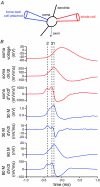


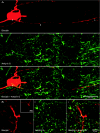

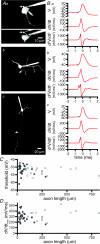

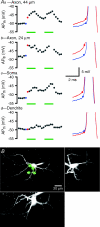


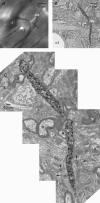
Comment in
-
Subthalamic firing without an end, but now with a beginning.J Physiol. 2008 Dec 1;586(23):5603. doi: 10.1113/jphysiol.2008.164806. J Physiol. 2008. PMID: 19043119 Free PMC article. No abstract available.
Similar articles
-
Sparse but selective and potent synaptic transmission from the globus pallidus to the subthalamic nucleus.J Neurophysiol. 2009 Jul;102(1):532-45. doi: 10.1152/jn.00305.2009. Epub 2009 May 20. J Neurophysiol. 2009. PMID: 19458148 Free PMC article.
-
A novel role for MNTB neuron dendrites in regulating action potential amplitude and cell excitability during repetitive firing.Eur J Neurosci. 2008 Jun;27(12):3095-108. doi: 10.1111/j.1460-9568.2008.06297.x. Eur J Neurosci. 2008. PMID: 18598256
-
Action potential initiation and propagation in rat neocortical pyramidal neurons.J Physiol. 1997 Dec 15;505 ( Pt 3)(Pt 3):617-32. doi: 10.1111/j.1469-7793.1997.617ba.x. J Physiol. 1997. PMID: 9457640 Free PMC article.
-
GABAergic control of the subthalamic nucleus.Prog Brain Res. 2007;160:173-88. doi: 10.1016/S0079-6123(06)60010-1. Prog Brain Res. 2007. PMID: 17499114 Review.
-
Neuronal signaling in central nervous system.Sheng Li Xue Bao. 2011 Feb 25;63(1):1-8. Sheng Li Xue Bao. 2011. PMID: 21340428 Review.
Cited by
-
Pacemaking in dopaminergic ventral tegmental area neurons: depolarizing drive from background and voltage-dependent sodium conductances.J Neurosci. 2010 May 26;30(21):7401-13. doi: 10.1523/JNEUROSCI.0143-10.2010. J Neurosci. 2010. PMID: 20505107 Free PMC article.
-
Suppression of subthalamic nucleus activity by micromagnetic stimulation.IEEE Trans Neural Syst Rehabil Eng. 2015 Jan;23(1):116-27. doi: 10.1109/TNSRE.2014.2348415. Epub 2014 Aug 21. IEEE Trans Neural Syst Rehabil Eng. 2015. PMID: 25163063 Free PMC article.
-
Axonal Computations.Front Cell Neurosci. 2019 Sep 18;13:413. doi: 10.3389/fncel.2019.00413. eCollection 2019. Front Cell Neurosci. 2019. PMID: 31619963 Free PMC article. Review.
-
Sparse but selective and potent synaptic transmission from the globus pallidus to the subthalamic nucleus.J Neurophysiol. 2009 Jul;102(1):532-45. doi: 10.1152/jn.00305.2009. Epub 2009 May 20. J Neurophysiol. 2009. PMID: 19458148 Free PMC article.
-
Dynamic spike threshold and zero membrane slope conductance shape the response of subthalamic neurons to cortical input.J Neurosci. 2010 Sep 29;30(39):13180-91. doi: 10.1523/JNEUROSCI.1909-10.2010. J Neurosci. 2010. PMID: 20881137 Free PMC article.
References
-
- Afsharpour S. Light microscopic analysis of Golgi-impregnated rat subthalamic neurons. J Comp Neurol. 1985;236:1–13. - PubMed
-
- Albin RL, Young AB, Penney JB. The functional anatomy of basal ganglia disorders. Trends Neurosci. 1989;12:366–375. - PubMed
-
- Alle H, Geiger JR. Combined analog and action potential coding in hippocampal mossy fibers. Science. 2006;311:1290–1293. - PubMed
-
- Alvarez L, Macias R, Lopez G, Alvarez E, Pavon N, Rodriguez-Oroz MC, Juncos JL, Maragoto C, Guridi J, Litvan I, Tolosa ES, Koller W, Vitek J, DeLong MR, Obeso JA. Bilateral subthalamotomy in Parkinson's disease: initial and long-term response. Brain. 2005;128:570–583. - PubMed
Publication types
MeSH terms
Substances
Grants and funding
LinkOut - more resources
Full Text Sources

